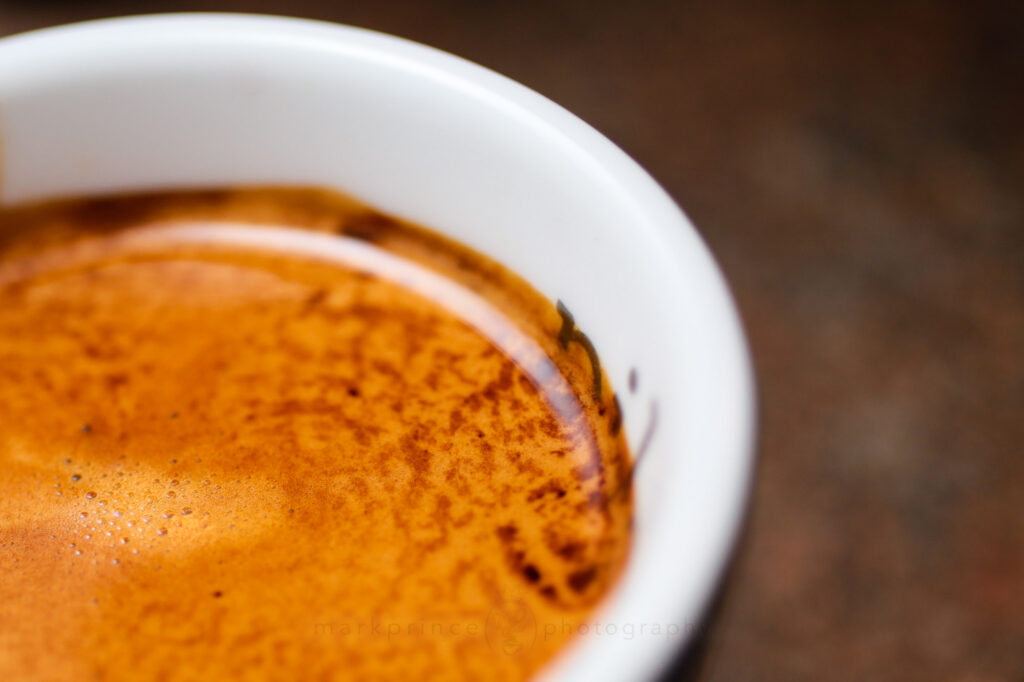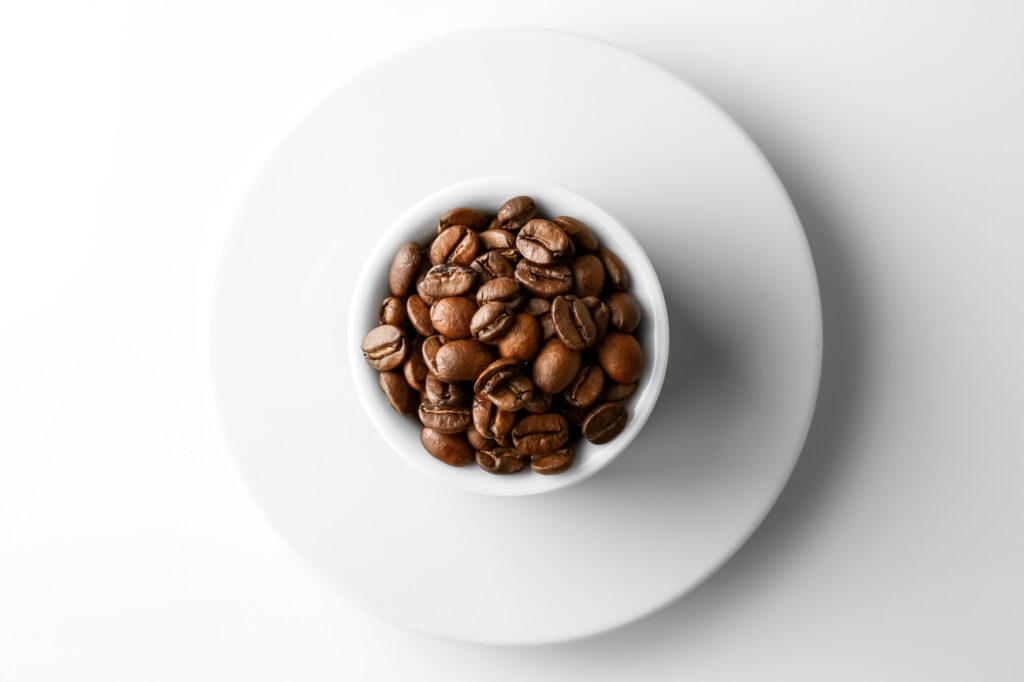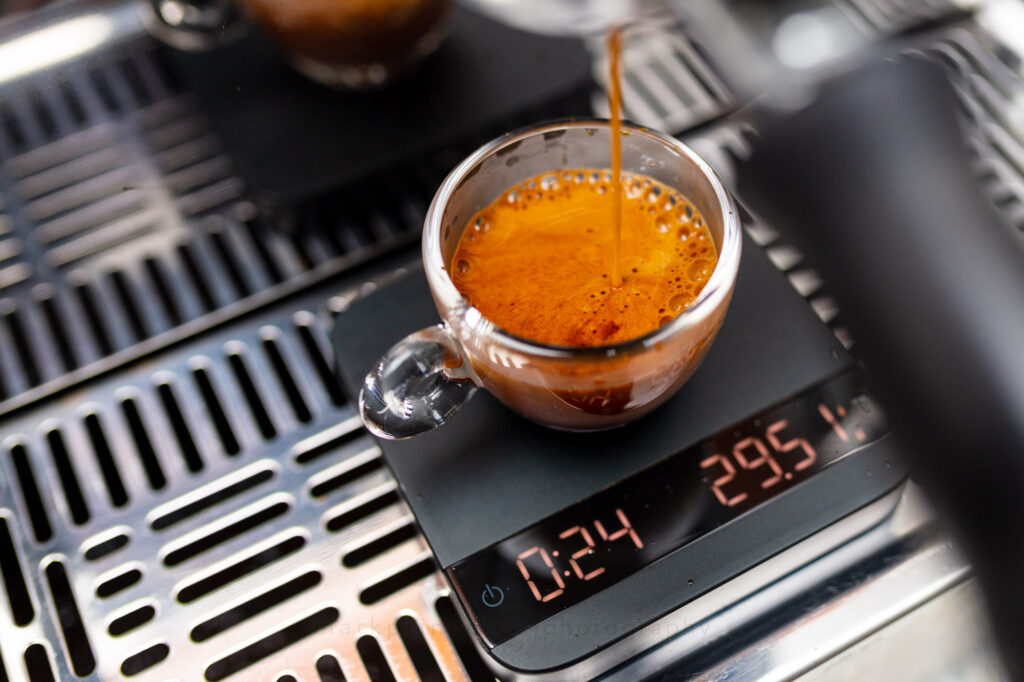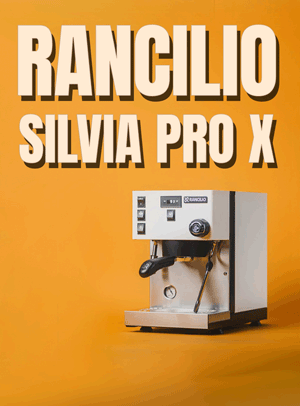Back in the late 1990s when I was still enjoying my twenties, I remember attending a local coffee demonstration at a Vancouver cafe. It was run by a guy who quite clearly believed he was the best coffee guy in Vancouver. He pulled shots of his house blend (a secret recipe – warning sign), wowed people with the level of crema on the shots (there wasn’t much), and bragged about the nuances of the taste and smell (all I remembered was burnt coffee smells).
But I’m not here to trash his coffee, some 20+ years later. Instead, something happened at that demo that really changed my focus on espresso and fine tuning it to make it better.
During a Q&A session after the demonstration, one person said they couldn’t make their espresso taste right at home, no matter what they did. As I recall, they complained about shots running too fast, taste too watery, and no crema. The host asked them to approach the grinder and espresso machine to see “how it is done”.
Before the customer did so, he asked if the host could use the coffee he brought with him to this demonstration, because he said (and I’m paraphrasing, as it was over 20 years ago) “I want to see how good this coffee can taste.” (I clearly remember it being JJ Bean’s coffee, a quality roaster in Vancouver)
The host really didn’t want to use JJ Bean’s coffee. I could understand why (a “my house, my rules, my coffee” thing) but the host made some lame excuses – “it’s too difficult to swap out the beans, look, my hopper is full of beans”, “all that ground coffee in the doser will be wasted” (another warning bell); “they’re not a good roaster” etc etc – but eventually he acquiesced. The doser was emptied (he saved the ground coffee for later use), the hopper was emptied (not a big deal) and the visitor’s coffee was poured into the grinder.
What happened next was comical. The host proceeded to plow through an entire 1lb bag of coffee, trying to “dial in” his grinder to the espresso machine. The entire time he made excuses about how bad the coffee was, he made excuses about how his grinder is entirely seasoned to his own coffee, he probably blamed the time of day too (that was probably his only valid excuse, ironically). But shot after shot after shot after shot was just horrible. Too fast. Too slow. Stalled. Too fast again. Stalled. Sour. By the end of the 16oz of coffee, he barely had passable shots that still ran crappy compared to his own coffee.
I do want to preface that, at that time, I didn’t know a lot about espresso, and was taking this guy – who had a long standing roastery in Vancouver – as an “expert”. It was only in the next few years that I realised this guy really didn’t know anything of value regarding modern day espresso. And I came to understand he really didn’t know his equipment.

Beautiful and Tasty Shot of Espresso
Espresso, the most difficult brewing method for coffee ever devised, constantly demands your attention, care, and growing experience. One learning tool to make better espresso is detailed in this feature article: Dialing in Espresso in Three Shot Pulls.
Dialing in Espresso
I did leave that demonstration thinking “wow, espresso is really hard to dial in”, and “wow, different coffees grind differently!”. The latter was a revelation for me. I also thought either the JJ Bean coffee was really bad (I knew even then it wasn’t, as they were one of the best roasteries in Vancouver at the time), or maybe there was something else about this.
I wrote up the experience in the old Usenet newsgroup alt.coffee, and the responses were swift and cutting: “that guy doesn’t know how to dial in espresso”; “nothing wrong with the coffee, everything wrong with his skill”; “people who know their equipment should be able to dial in any fresh roasted coffee for an espresso shot”. Etc. etc.
All of this started a journey. There was a yearning to learn what was clearly an art: dialing in an espresso blend for a good shot pull.
For the next three years, it became an obsession. I started attending barista events, jams and competitions, and asked questions. Asked for demonstrations. Picked up tips. Learned techniques. I learned how to analyse coffee grounds by touch and look. Spoke to people who obsessed with the fluid dynamics of the bed of coffee inside a portafilter. I sought out Illy’s mythical “transparent portafilter” to see if that could teach anything. Spoke to absolute experts in the field of espresso including David Schomer, Instaurator, Kent Bakke and others – just to namedrop a few – and the questions always steered towards dialing in an espresso blend.
More experience with different grinders was gained. Between 1998 and 2002, I had the good fortune of using over two dozen different grinders designed primarily for espresso, from Rancilio Rockys to Macap M4s, from Mazzer Minis to Nuova Simonelli ECFs. There was even an obscure Krups doser grinder from the early 1990s that got some testing. I learned how each had different ways of changing the grind. Learned about grind retention, burr designs, shapes and sizes, and RPMs and its effect.
By 2003, when I started teaching my own informal espresso courses, a mantra evolved: Attempt to dial in any coffee suited for espresso, on any coffee grinder designed for espresso grinding, in three shot pulls. Take 60 grams of coffee, and by the time it’s used up, have the grinder tuned to what the espresso machine is capable of producing.
Did it happen every time? Hell no. For many years, it was a goal, not a fait accompli. But along the way, I did get incrementally better at doing it, especially as I got to use more and more different coffee grinders, more and more different espresso machines, and more and more different coffees.
Today, I strongly feel being able to dial in any espresso blend (or single origin) on a grinder and espresso machine you aren’t familiar with is the strongest sign of a quality barista: either professional or the home grown variety. I even suggested basing barista competitions around this skill. If you are able to do this, it will show that you have a deep level of technique, understanding, and diagnosis skills to make coffee sing.
How do you get there? Let’s share a few things learned along the way.
NB: this article assumes you’re using a 0.1g scale to measure your coffee all the time.
Every Coffee is Different
The very first thing to learn is the same lesson I learned back in the late 1990s: every roasted coffee is different, and grinds differently. Not only that, but coffee changes as it ages: a 5 day old coffee will grind differently than a 10 or 15 day old coffee of the same exact type. There’s a third element: relative humidity and temperatures in the air change how coffee grinds. The first shot of the day may run perfect, but an identical dose of the same coffee ground in the afternoon – after the sun has been shining in your kitchen (and on the grinder) for 3 hours – will probably run fast.
Different roast levels grind differently: darker roasts tend to run faster and with less crema than medium or lighter roasts, when ground with the same grinder setting.
Different bean types grind differently, even if they have the same roast appearance. A maragogype bean is going to grind differently than a caturra, or a mandheling, or a peaberry. Generally, the bigger the original coffee bean, the less dense its structure, and faster it will grind, with more varied particle sizes. This all affects how a shot pull occurs, if you never change the grind setting.
This is your first piece of ammo: know that when you change the coffee in your grinder, from one origin to another (from the same roaster), from a single origin to a blend, or from one roaster to another, the coffee is going to grind differently, and you have to account for that. Even before your first shot pull, even before you decide to change a grind setting, a dose amount, or an espresso machine temperature.

Coffee Beans Can Be Different
Coffee beans can vary widely from type to type, and change in density, inner volume, and more. Roast levels change beans too and how your grinder works with them.
Grind Analysis
A long time ago, someone taught me to touch coffee.
John Blackwell from La Marzocco taught me that lesson. He prepped a shot for me, and for whatever reason the shot was off. Then he did something I had never seen before: he ground off a bit of coffee and felt it. Rubbed it between his fingers. He made a slight adjustment to the grinder and felt the grind again. Satisfied, he ground off a full dose for a double shot, pulled it and served up a great double shot of espresso to taste.
When asked what was up with all that, Blackwell ground a bit more coffee, and he put some in my hand and kept some for himself. We started rubbing the granules between thumb and forefinger. He told me to get familiar with that texture. Paraphrasing him, he said “That’s the kind of grain you want in an espresso grind. Note it’s not like talcum powder, but it’s also not like auto drip. What does it make you think of?”
My initial thought was: slightly finer than table salt. It was definitely finer than refined sugar, and much coarser than flour. It felt like fine salt, but even smaller with some variance (salt often feels homogenous – all the same size). I can’t remember if I told him that or salt was the right answer, but I do stick to that comparison to this day: your starter espresso grind should feel a bit finer than fine table salt.
That was another “a-ha” moment, and since that time, I’ve learned to touch and feel the grind for espresso. In the beginning, the coffee and grinder would get dialed in, produce a decent tasting shot of espresso, and then it was time to feel the grind in order to get a sense of touch for what a good grind was. This was the process for a year or two as familiarity set in one what a good grind granule size should feel like.
Then a change came: instead of feeling the grind after a good shot pull, the grind was sampled and felt as soon as the beans were added to the grinder, before any shots. The tactile memory of what a good coffee grinder should feel like was put into operation. If the grinder output didn’t feel right, the grinder got adjusted, and the process would start again. Once the granular nature of the grinds seemed good, the first shot pulls were attempted.
For you, the same path is recommended. Don’t use touch initially in your set up process, but use touch of the coffee grounds after you’re happy with your shot pulls. Get your grinder and espresso machine singing to each other? That’s when you grind out a gram or so and rub it between your thumb and forefinger. Get a sense of that feel, that particle granule size. Get familiar with it by doing it dozens, if not hundreds of times over a few months or even longer.
Then, when you feel confident in knowing the “feel”, use it as your first tool to dial in a new coffee to your grinder, before you even pull a shot. You’ve just added a new bit of ammo to your espresso making arsenal.

Uncompacted Grind Particles
Nice fluffy grinds from a Sette grinder, dosed out into a "volcano" mound, means almost no compaction. The grind fineness is that of extra fine table salt.
Pull that First Shot
Baselines are good to have in all coffee preparation, but especially in making espresso. However, don’t be afraid to adjust them depending on the machine and grinder you’re using.
Take my home setup for example: a Baratza Sette 270Wi grinder and a La Marzocco GS3, with it’s 58mm, VST basket setup. The baseline setup for those two pieces of equipment is 18.5g of coffee with a shot pull time of around 30 seconds (including preinfusion), resulting in 45g of espresso brewed. Whenever a new coffee is put into the Sette grinder, that’s the baseline setting.
But what the machine is an Elektra Micro Casa a Leva lever machine, but you’re still using the Sette grinder? The Elektra’s filter basket is 49mm in diameter and holds 15.5g comfortably. Also the shot volumes coming out of the Elektra will max out at around 40-45g and not a drop more.
This is where familiarity with your brewing equipment comes into play and how your grinder needs to be adjusted to deal with the limitations of that equipment. For example: if the Elektra can only use 15.5g of coffee, you’d think that the same grind from the 18.5g dose in the La Marzocco machine would run fast (aka be a gusher) in the Elektra.
Now, if the Elektra basket and La Marzocco VST basket held the same vertical height of coffee (the coffee puck) the Elektra’s 15.5g would most likely produce a gusher. But there’s another factor at play here: the Elektra’s 49mm basket actually holds a taller coffee puck than the 58mm basket of the La Marzocco. That taller puck of coffee means more resistance for the pressurized water attempting to flow through it.
And there’s still one more thing at play: the narrower diameter of the Elektra basket means even more resistance for the pressurized water.
Knowing all of these variables (which mainly comes from experience, but also just thinking through your equipment’s design, features and limitations), my first instinct is to not touch the grinder settings at all (if it was last used for the La Marzocco) before pulling the first Elektra shot. Instead, pull the lower-dosed shot to see how the Elektra delivers that coffee. If it runs fast, you know you have some things to do, including making the grind finer from the grinder or altering the dose on the next shot pull. If it runs the same, you know you don’t need to do anything.
The lesson here: once you think your grind fineness level is good (through touch and previous use) on a grinder, go ahead and pull that first shot (out of your three dial in shots) with your usual dose of coffee for that specific espresso machine to see how the shot pulls. This is where you use your senses, experience, and equipment knowledge, to see if any adjustments need to be made before your second shot pull.

Pulling a Double Shot
Pulling a double shot, using a scale to measure the output (and in this case, the time as well), all part of the tools to make espresso better.
Know Your Grinder’s Limitations and Work With Them
Not everyone has a Versalab M4 grinder to pull shots with. Not everyone has an Mahlkonig EK43. And not everyone has a Compak K10 Conic to make espresso with. What do these grinders have in common? They allow for stepless, infinite grind adjustments.
Many people are working with grinders that have maybe 3 or 4 “clicks” on their grind adjustment to play with for espresso sized grinds. Some may have as many as 10 or 20 settings they can use to get particles in the range of espresso. The fact is, on some grinders, the difference between one “click” on a grind adjustment can be the difference between a double shot that runs for 15 seconds to produce 60ml, and 40 seconds to produce that same 60ml (if the dose weight is the same).
But you can work with that. This is where your dose – the weight of the ground coffee you’re using for your espresso machine and portafilter – can be controlled and changed by you. Never be chained to a fixed dose weight for espresso. If you learned to pull shots with 18.5g of coffee for a double, consider that your baseline, not the rigid, be all, must be amount.
When dialing in a new coffee roast for espresso, after the first double shot is pulled, there will either be an adjustment to the grinder (if the double runs super fast or slow), or an adjustment to the dose used (if the double shot is close to being okay). Part of this process is knowing what your grinder is capable of when you’re changing the grind.
If you’re working with a Baratza Vario grinder and its micro and macro grind adjustments, then fiddle with the grinder’s micro adjustments up or down before changing my dose weight because there’s 20 different micro adjustments that can be made.. If you’re working on a Rancilio Rocky which has pretty big jumps in grind fineness levels between clicks, gravitate towards changing your output dose weight.
A safe dose adjustment volume is 1.5 grams, up or down. So if your baseline is 18g, go as far down as 16.5g and up to 19.5g to dial in your shot pull. Here is one example of how to use this:
Let’s say you’re pulling double shots with a Baratza Virtuoso+, and dosing out 14.5g for a shot with an Elektra lever machine. You get a 40g double shot in 20 seconds. What to do? Try upping the dose by 1g without changing anything on the grinder. However, If that shot runs in 15 seconds for 40g, try going one full click finer on the Virtuoso+, then dose the same volume of coffee out again (14.5g) and see if that gives you a better running shot in the 25 second range.
When dialing in a new coffee roast for espresso, this is the first element you should consider adjusting after being happy with the grind fineness level: Adjust the dose by as much as 1.5g up or down. If the grinder you’re working produces a shot that’s just a bit stalled at, say “7” on its grind dial, but runs way too fast at “8” for the same dose, go back to “7” and use 1g less coffee on your next double shot pull.
Taste
When dialing in a new coffee – single origin or blend – for espresso, taste everything. Even the worst, gusher shots. Even the super slow, poured out 10ml shots. Taste experience is part of your arsenal for making better espresso and achieving the goal of being able to dial in any coffee, on any grinder, with any espresso machine within three double shot pulls.
Sometimes espresso can surprise you. A shot that looks blond, thin crema, and took too long to pull might taste absolutely fantastic. And equally, sometimes when a shot looks visually perfect, it might taste sour or bitter, or just bland. Always taste everything, Gordon Ramsay said, and we do as well at CoffeeGeek.
Tasting is especially important in the middle of your 3 dial in shot pulls because it helps you identify issues with the espresso machine, including brewing temperatures, machine cleanliness, and even how well the coffee puck was tamped and prepared.
If you have an espresso machine with temperature settings that can be adjusted, your taste will help guide you in possibly changing this to produce a better shot. Shot tastes sour? The machine’s temperature is too low. Shot tastes burnt and bitter? Brewing temperatures might be too high.
What if your machine doesn’t have temperature controls? You can still tweak things up or down by flushing the brewing group for 5 seconds (to heat it up more) before putting the portafilter in place and pulling your shot, or running your portafilter under cold water for a few seconds to cool things down a bit. Think out of the box if your espresso machine has limitations. I remember once wrapping a cold cloth around the grouphead of a lever espresso machine to get the water temperature down to alleviate a problem with too-bitter shots, and it worked.
If you taste a weak, over extracted coffee, one culprit might be your tamping technique. Pressurized water will always follow the path of least resistance, and if there’s an imbalance in your tamping, where one side of the puck seems higher than the opposite side, you will produce an over extracted double shot, because more water ran through the thinner part of the puck than the thicker part. Taste will help you see these kinds of errors.
Taste will also tell you it’s time to clean your machine. You do regularly clean your espresso machine: it’s dispersion screen; the inside of the portafilter; backflushing the lines; and making sure the underside of your filter basket is clean? If not, you may pick up some astringent and even rancid tastes in your shot pull.
That Third Shot
By the time you arrive at the third shot pull, you may have made a ton of adjustments, or just a few minor tweaks. How did you get there?
All your hard work comes after the first shot pull, using your analytical brain to figure out what grind setting needs adjusting, what dose tweak is needed, if the machine’s temperature needs a change, and if your tamping game needs some fine tuning. You should see your biggest change to better between your first shot and your second.
But what if that’s not the case? What if all your tweaks resulted in a worse second shot pull? Don’t panic! Instead, put your skills and thoughts into overdrive, analysing why the shot is worse.
Did it gush out just like the first shot, even if you added a gram to your dose? The solution might be going a full click finer on the grinder (and grinding off some coffee into the waste bin to get rid of any ground coffee left in the grinder between uses), and dropping back down to your original dose amount.
Maybe your shot times are bang on the second time, but the shot just tastes worse? It’s possible that coffee is better suited for a faster (or slower) running shot. Again, experience is your best weapon here: learn each time what change makes what effect, and put that into your catalog of skills.
And at the end of the day, that’s what’s going to make your espresso better: experience. Experience with failures, attempts to fix failures, and failing again. As long as you learn just a smidge every time, getting to that goal of a dialed in third shot of espresso can be a reality in a few months, or maybe a few years down the road.
This is why I implore you to not be disappointed if your third shot pull fails to hit the mark and results in a less than perfect shot of espresso, when introducing a new coffee to your home setup. It’s quite hard to achieve this if you’re being completely honest with yourself.
I’ve been doing this for over 20 years now, and I still don’t get it at times. Indeed, the inspiration for this article was a rather excellent decaf espresso received recently that took me six dial in shot pull attempts (with a bevy of adjustments in between each) to get it right. Once the grinder, coffee and espresso machine were singing, it was an absolutely divine double shot of espresso.
The fantastic thing about that six dial in attempts? Once again, I managed to learn something new that hopefully will improve my skills. And that is the real goal and reward of the “Three Shot Pulls to Dial in Espresso” mantra: it’s not about getting a perfect shot in three shot pulls, and everything about being a better barista.























